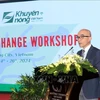The Sendai Framework and the 2015 Global Assessment Report on Disaster Risk Reduction were introduced at a conference held in Hanoi on June 2.
The conference was jointly organised by the United Nations Development Programme (UNDP) in Vietnam, the United Nations Office for Disaster Risk Reduction (UNISDR) and the Ministry of Agriculture and Rural Development (MARD).
Speaking at the event, UNDP Deputy Country Director Bakhodir Burkhanov said the Sendai Framework for Disaster Risk Reduction was adopted by the United Nations (UN) member states at the Third UN World Conference on Disaster Risk Reduction in Sendai City, Japan in March this year in an effort to guide the countries in preventing disaster losses in the future.
Vietnam has made notable contributions to regional and global agendas on disaster risk reduction (DRR) and sustainable development, enabling greater cooperation between UN member states in tackling the issue. The country has taken action to improve the effectiveness of disaster risk reduction at local and global levels, Burkhanov noted.
He believed the country would continue to play an active role in disaster management given the DRR programme’s addition into Vietnam’s socio-economic development plan between 2015 and 2030.
Dang Quang Minh, Deputy Director of Disaster Management Centre under the MARD, briefed participants on Vietnam’s priorities to implement the Sendai Framework, adding that the country has been encouraging the private sector to participate in DRR activities as well as promoting the active involvement of communities, notably vulnerable people such as women and children, in the effort.
Vietnam has increasingly applied science and advanced technology in disaster monitoring, forecast and assessment and fostered more capable governmental disaster management bodies at all levels, he said.
Vietnam has worked with the UNDP in national forums on DRR and climate change adaption in implementing its action plan.
For his part, Andrew Maskrey from the UNISDR gave an overview of the 2015 Global Assessment Report on Disaster Risk Reduction.
According to the report, the average annual losses from earthquakes, tsunamis, tropical cyclones and river flooding are estimated at 314 billion USD in the construction sector alone. The figure would be even higher if it included other hazards, such as drought, and other sectors, such as agriculture.
If this risk is not reduced, expected future losses will become a critical opportunity cost for development. Especially in those countries where disaster risk represents a significant proportion of capital investment and social expenditure, the capacity for future development will be seriously undermined. Investing in DRR is thus a precondition for developing sustainably in a changing climate.-VNA
The conference was jointly organised by the United Nations Development Programme (UNDP) in Vietnam, the United Nations Office for Disaster Risk Reduction (UNISDR) and the Ministry of Agriculture and Rural Development (MARD).
Speaking at the event, UNDP Deputy Country Director Bakhodir Burkhanov said the Sendai Framework for Disaster Risk Reduction was adopted by the United Nations (UN) member states at the Third UN World Conference on Disaster Risk Reduction in Sendai City, Japan in March this year in an effort to guide the countries in preventing disaster losses in the future.
Vietnam has made notable contributions to regional and global agendas on disaster risk reduction (DRR) and sustainable development, enabling greater cooperation between UN member states in tackling the issue. The country has taken action to improve the effectiveness of disaster risk reduction at local and global levels, Burkhanov noted.
He believed the country would continue to play an active role in disaster management given the DRR programme’s addition into Vietnam’s socio-economic development plan between 2015 and 2030.
Dang Quang Minh, Deputy Director of Disaster Management Centre under the MARD, briefed participants on Vietnam’s priorities to implement the Sendai Framework, adding that the country has been encouraging the private sector to participate in DRR activities as well as promoting the active involvement of communities, notably vulnerable people such as women and children, in the effort.
Vietnam has increasingly applied science and advanced technology in disaster monitoring, forecast and assessment and fostered more capable governmental disaster management bodies at all levels, he said.
Vietnam has worked with the UNDP in national forums on DRR and climate change adaption in implementing its action plan.
For his part, Andrew Maskrey from the UNISDR gave an overview of the 2015 Global Assessment Report on Disaster Risk Reduction.
According to the report, the average annual losses from earthquakes, tsunamis, tropical cyclones and river flooding are estimated at 314 billion USD in the construction sector alone. The figure would be even higher if it included other hazards, such as drought, and other sectors, such as agriculture.
If this risk is not reduced, expected future losses will become a critical opportunity cost for development. Especially in those countries where disaster risk represents a significant proportion of capital investment and social expenditure, the capacity for future development will be seriously undermined. Investing in DRR is thus a precondition for developing sustainably in a changing climate.-VNA



















